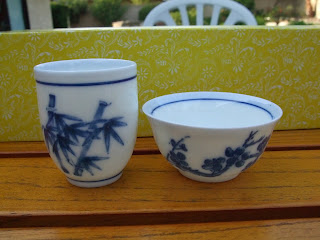Hundred Year Tree (description; $18/25 grams)
This is definitely the most I've ever paid for tea so far, but the price really is worth it. I've decided to slowly try all of The Tea Gallery's Wuyi offerings, ordering a few every so often until I've sampled them all. That's how amazing their tea is. I first brewed using 5 grams for my 120 ml teapot, which turned out okay. There was nice aroma and flavor profile, but I was kind of disappointed with the lack of a "tea high." I moved through all my samples once before coming back to this one. I decided to amp up the amount to 5.5 grams, and I brewed it with a heavy hand ... and jackpot.
It's useless to write a review of this tea, because what I experienced could not be described with words. I think they did a very nice job of describing the aroma very well in their description...can't really add much to that. Even though I like the Shi Lan more, I think I like the feeling this tea gives me the best. It had a profound calming effect, and I felt a tingling sensation go through my entire body. It was mind-blowing, and I don't mind that in a hyperbolic way, I was literally out of my mind for a few hours afterward.
I'm adding this to the list of "things to reorder" after I make it around all of The Tea Gallery's fine selection. A big thumbs up on this one!
(I realized that I said I would post about The Tea Gallery's Classic Roast vs. Just 4 Tea Classic Roast, but I just needed to post about this exquisite tea.)
*EDIT*
I was mulling over what I had written for this post, and I have a confession to make. I wrote this draft right after my cha qi high on my 2nd time trying this (which is why the review is so gushing), but on the 3rd and 4th go with this tea, the cha qi was absent. Looking back at my notes, reading what I had written, mulling over the tea in my head...I think I probably wouldn't re-order this tea. It's an interesting tea, and the old tree aspect probably gives the tea great depth. I like some of the other Tea Gallery selections better, such as the Shi Lan. I would probably feel differently though, if I could nail that cha qi feeling everytime I brewed this.

















